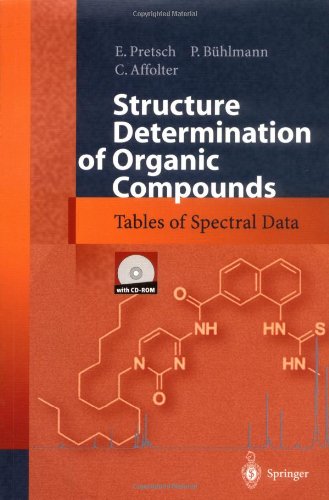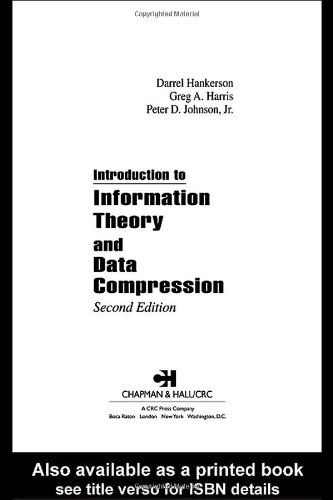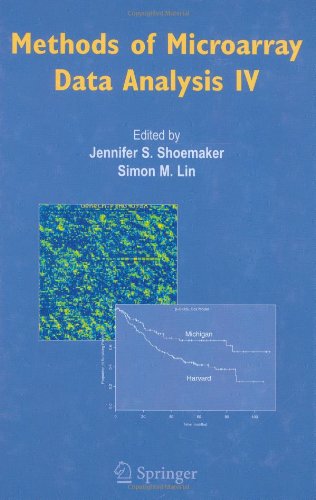E. Pretsch, P. Bühlmann, C. Affolter9783540678151, 3-540-678-15-8, 3-540-67815-8
Table of contents :
Front Matter……Page 1
Table of Contents……Page 0
Table of Contents……Page 3
Preface……Page 12
1.1 Scope and Organization……Page 13
1.2 Abbreviations and Symbols……Page 15
2.1.1 Calculation of the Number of Double Bond Equivalents from the Molecular Formula……Page 16
2.1.2 Properties of Selected Nuclei……Page 17
2.2 ^13 C NMR Spectroscopy……Page 18
2.3 ^1 H NMR Spectroscopy……Page 21
2.4 IR Spectroscopy……Page 24
2.5.1 Average Masses of Naturally Occurring Elements with Exact Masses and Representative Relative Abundances of Isotopes……Page 29
2.5.2 Ranges of Natural Isotope Abundances of Selected Elements……Page 35
2.5.3 Isotope Patterns of Naturally Occurring Elements……Page 36
2.5.4 Calculation of Isotope Distributions……Page 37
2.5.5 Isotopic Abundances of Various Combinations of Chlorine, Bromine, Sulfur, and Silicon……Page 39
2.5.6 Isotope Patterns of Combinations of Cl and Br……Page 41
2.5.7 Indicators of the Presence of Heteroatoms……Page 42
2.5.8 Rules for Determining the Relative Molecular Weight (M_r)……Page 44
2.5.9 Homologous Mass Series as Indications of Structural Type……Page 45
2.5.10 Mass Correlation Table……Page 47
2.5.11 References……Page 57
2.6 UV/Vis Spectroscopy……Page 58
3.1 Alkanes, Cycloalkanes……Page 60
3.2 Alkenes, Cycloalkenes……Page 61
3.3 Alkynes……Page 62
3.4 Aromatic Hydrocarbons……Page 63
3.5 Heteroaromatic Compounds……Page 64
3.6 Halogen Compounds……Page 65
3.7.1 Alcohols and Phenols……Page 67
3.7.2 Ethers……Page 68
3.8.1 Amines……Page 70
3.8.2 Nitro Compounds……Page 71
3.9 Thiols and Sulfides……Page 73
3.10.1 Aldehydes……Page 74
3.10.2 Ketones……Page 75
3.10.3 Carboxylic Acids……Page 76
3.10.4 Carboxylic Esters and Lactones……Page 77
3.10.5 Carboxylic Amides and Lactams……Page 79
4.1.1 Chemical Shifts……Page 81
4.1.2 Coupling Constants……Page 90
4.1.3 References……Page 91
4.2.1 Chemical Shifts……Page 92
4.2.2 Coupling Constants……Page 96
4.2.3 References……Page 97
4.3.1 Chemical Shifts……Page 98
4.3.3 References……Page 99
4.4.1 Chemical Shifts……Page 100
4.4.3 References……Page 105
4.5.1 Chemical Shifts……Page 106
4.5.2 Coupling Constants……Page 112
4.5.3 References……Page 113
4.6.1 Chemical Shifts……Page 114
4.6.2 Coupling Constants……Page 121
4.7.1 Fluoro Compounds……Page 122
4.7.2 Chloro Compounds……Page 124
4.7.3 Bromo Compounds……Page 125
4.7.5 References……Page 126
4.8.1 Alcohols……Page 127
4.8.2 Ethers……Page 129
4.9.1 Amines……Page 131
4.9.2 Nitro and Nitroso Compounds……Page 133
4.9.4 Imines and Oximes……Page 134
4.9.5 Hydrazones and Carbodiimides……Page 135
4.9.6 Nitriles and Isonitriles……Page 136
4.9.8 References……Page 137
4.10.2 Sulfides……Page 138
4.10.4 Sulfoxides and Sulfones……Page 140
4.10.6 Sulfurous and Sulfuric Acid Derivatives……Page 141
4.10.7 Sulfur-Containing Carbonyl Derivatives……Page 142
4.11.1 Aldehydes……Page 143
4.11.2 Ketones……Page 144
4.11.3 Carboxylic Acids and Carboxylates……Page 146
4.11.4 Esters and Lactones……Page 148
4.11.5 Amides and Lactams……Page 150
4.11.6 Miscellaneous Carbonyl Derivatives……Page 152
4.12.1 Derivatives of Group IV Elements……Page 154
4.12.2 Phosphorus Compounds……Page 155
4.12.3 Miscellaneous Organometallic Compounds……Page 157
4.13.1 Amino Acids……Page 158
4.13.2 Carbohydrates……Page 162
4.13.3 Nucleotides and Nucleosides……Page 164
4.13.4 Steroids……Page 166
4.14.1 ^13 C NMR Spectra of Common Deuterated Solvents……Page 167
4.14.2 ^13 C NMR Spectra of Secondary Reference Compounds……Page 169
4.14.3 ^13 C NMR Spectrum of a Mixture of Common Nondeuterated Solvents……Page 170
5.1.1 Chemical Shifts……Page 171
5.1.2 Coupling Constants……Page 176
5.1.3 References……Page 177
5.2.1 Substituted Ethylenes……Page 178
5.2.2 Dienes……Page 184
5.3.1 Chemical Shifts and Coupling Constants……Page 185
5.4 Alicyclics……Page 186
5.5 Aromatic Hydrocarbons……Page 190
5.6.1 Non-Condensed Heteroaromatic Rings……Page 196
5.6.2 Condensed Heteroaromatic Rings……Page 203
5.7.1 Fluoro Compounds……Page 208
5.7.2 Chloro Compounds……Page 209
5.7.3 Bromo Compounds……Page 210
5.7.4 Iodo Compounds……Page 211
5.8.1 Alcohols……Page 212
5.8.2 Ethers……Page 214
5.9.1 Amines……Page 217
5.9.3 Nitrosamines, Azo and Azoxy Compounds……Page 220
5.9.4 Imines, Oximes, Hydrazones, and Azines……Page 221
5.9.5 Nitriles and Isonitriles……Page 222
5.9.6 Cyanates, Isocyanates, Thiocyanates, and Isothiocyanates……Page 223
5.10.1 Thiols……Page 224
5.10.2 Sulfides……Page 225
5.10.4 Sulfoxides and Sulfones……Page 226
5.10.6 Thiocarboxylate Derivatives……Page 227
5.11.1 Aldehydes……Page 228
5.11.2 Ketones……Page 229
5.11.3 Carboxylic Acids and Carboxylates……Page 230
5.11.4 Esters and Lactones……Page 231
5.11.5 Amides and Lactams……Page 233
5.11.6 Miscellaneous Carbonyl Derivatives……Page 236
5.12.1 Silicon Compounds……Page 238
5.12.2 Phosphorus Compounds……Page 239
5.12.3 Miscellaneous Compounds……Page 242
5.13.1 Amino Acids……Page 243
5.13.2 Carbohydrates……Page 246
5.13.3 Nucleotides and Nucleosides……Page 247
5.13.4 References……Page 249
5.14.1 ^1 H NMR Spectra of Common Deuterated Solvents……Page 250
5.14.2 ^1 H NMR Spectra of Secondary Reference Compounds……Page 252
5.14.3 ^1 H NMR Spectrum of a Mixture of Common Nondeuterated Solvents……Page 253
6.1 Alkanes……Page 254
6.2.1 Monoenes……Page 257
6.2.2 Allenes……Page 260
6.3 AIkynes……Page 261
6.4 Alicyclics……Page 262
6.5 Aromatic Hydrocarbons……Page 264
6.6 Heteroaromatic Compounds……Page 267
6.7.1 Fluoro Compounds……Page 269
6.7.2 Chloro Compounds……Page 270
6.7.4 Iodo Compounds……Page 271
6.8.1 Alcohols and Phenols……Page 272
6.8.2 Ethers, Acetals, Ketals……Page 273
6.8.3 Epoxides……Page 275
6.8.4 Peroxides and Hydroperoxides……Page 276
6.9.1 Amines and Related Compounds……Page 277
6.9.2 Nitro and Nitroso Compounds……Page 279
6.9.3 Imines and Oximes……Page 281
6.9.4 Azo Compounds……Page 283
6.9.5 Nitriles and Isonitriles……Page 284
6.9.6 Diazo Compounds……Page 285
6.9.7 Cyanates and Isocyanates……Page 286
6.9.8 Thiocyanates and Isothiocyanates……Page 287
6.10.1 Thiols and Sulfides……Page 289
6.10.2 Sulfoxides and Sulfones……Page 290
6.10.4 Thiocarbonic Acid Derivatives……Page 292
6.11.1 Aldehydes……Page 295
6.11.2 Ketones……Page 296
6.11.3 Carboxylic Acids……Page 299
6.11.4 Esters and Lactones……Page 301
6.11.5 Amides and Lactams……Page 304
6.11.6 Acid Anhydrides……Page 307
6.11.7 Acid Halides……Page 309
6.11.8 Carbonic Acid Derivatives……Page 310
6.12.1 Silicon Compounds……Page 313
6.12.2 Phosphorus Compounds……Page 314
6.12.3 Boron Compounds……Page 317
6.13 Amino Acids……Page 318
6.14.1 Infrared Spectra of Common Solvents……Page 319
6.14.2 Infrared Spectra of Suspension Media……Page 320
6.14.3 Interferences in Infrared Spectra……Page 321
7.1.2 Branched Alkanes……Page 322
7.1.3 References……Page 323
7.2.2 Branched Alkenes……Page 324
7.2.4 References……Page 325
7.3.2 References……Page 326
7.4.1 Cyclopropanes……Page 327
7.4.4 Cyclohexenes……Page 328
7.4.5 References……Page 329
7.5.2 Alkylsubstituted Aromatic Hydrocarbons……Page 330
7.5.3 References……Page 331
7.6.3 Thiophenes……Page 332
7.6.5 Pyridines……Page 333
7.6.7 Pyridazines and Pyrimidines……Page 334
7.6.10 Quinolines and Isoquinolines……Page 335
7.6.12 References……Page 336
7.7.1 Saturated Aliphatic Halides……Page 337
7.7.4 References……Page 338
7.8.1 Aliphatic Alcohols……Page 339
7.8.4 Vicinal Glycols……Page 340
7.8.7 Benzyl Alcohols……Page 341
7.8.8 Aliphatic Ethers……Page 342
7.8.9 Unsaturated Ethers……Page 343
7.8.11 Cyclic Ethers……Page 344
7.8.12 Aliphatic Epoxides……Page 345
7.8.16 Aliphatic Peroxides……Page 346
7.8.17 References……Page 347
7.9.2 Cycloalkylamines……Page 348
7.9.3 Cyclic Amines……Page 349
7.9.6 Aliphatic Nitro Compounds……Page 350
7.9.10 Aliphatic Azides……Page 351
7.9.12 Aliphatic Nitriles……Page 352
7.9.15 Aromatic Isonitriles (R-NC)……Page 353
7.9.18 Aliphatic Isocyanates (R-NCO)……Page 354
7.9.20 Aliphatic Thiocyanates (R-SCN)……Page 355
7.9.23 Aromatic Isothiocyanates (R-NCS)……Page 356
7.9.24 References……Page 357
7.10.2 Aromatic Thiols……Page 358
7.10.4 Alkyl Vinyl Sulfides……Page 359
7.10.7 Disulfides……Page 360
7.10.9 Alkyl Aryl and Diaryl Sulfoxides……Page 361
7.10.10 Aliphatic Sulfones……Page 362
7.10.12 Alkyl Aryl Sulfones……Page 363
7.10.15 Alkylsulfonic Acid Esters……Page 364
7.10.17 Aromatic Sulfonamides……Page 365
7.10.19 References……Page 366
7.11.3 Aromatic Aldehydes……Page 367
7.11.6 Alicyclic Ketones……Page 368
7.11.8 Aliphatic Carboxylic Acids……Page 369
7.11.11 Saturated Aliphatic Esters……Page 370
7.11.12 Unsaturated Esters……Page 371
7.11.13 Esters of Aromatic Acids……Page 372
7.11.15 Aliphatic Amides……Page 373
7.11.18 Lactams……Page 374
7.11.19 Imides……Page 376
7.11.20 References……Page 377
7.12.3 Aliphatic Phosphines and Phosphine Oxides……Page 378
7.12.5 References……Page 379
7.13.1 Electron Impact Ionization Mass Spectra of Common Solvents……Page 380
7.13.2 Spectra of Common FAB MS Matrix and Calibration Compounds……Page 383
7.13.3 Spectra of Common MALDI MS Matrix Compounds……Page 389
7.13.4 References……Page 392
8.2 UV/Vis Absorption of Simple Chromophores……Page 393
8.3.1 UV Absorption of Dienes and Polyenes……Page 395
8.3.2 UV Absorption of Alpha,Beta-Unsaturated Carbonyl Compounds……Page 396
8.4.1 UV Absorption of Monosubstituted Benzenes……Page 398
8.4.2 UV Absorption of Substituted Benzenes……Page 399
8.4.3 UV Absorption of Aromatic Carbonyl Compounds……Page 400
8.5.1 UV/Vis Spectra of Alkenes and Alkynes……Page 401
8.5.2 UV/Vis Spectra of Aromatic Compounds……Page 402
8.5.3 UV/Vis Spectra of Heteroaromatic Compounds……Page 407
8.5.4 UV/Vis Spectra of Miscellaneous Compounds……Page 409
8.5.5 UV/Vis Spectra of Nucleotides……Page 411
8.6 UV/Vis Absorption of Common Solvents……Page 412
A……Page 413
B……Page 420
C……Page 425
D……Page 432
E……Page 439
F……Page 442
G……Page 443
H……Page 444
I……Page 446
K……Page 448
L……Page 449
M……Page 450
N……Page 454
O……Page 456
P……Page 457
R……Page 462
S……Page 463
T……Page 465
V……Page 472
Z……Page 473







Reviews
There are no reviews yet.